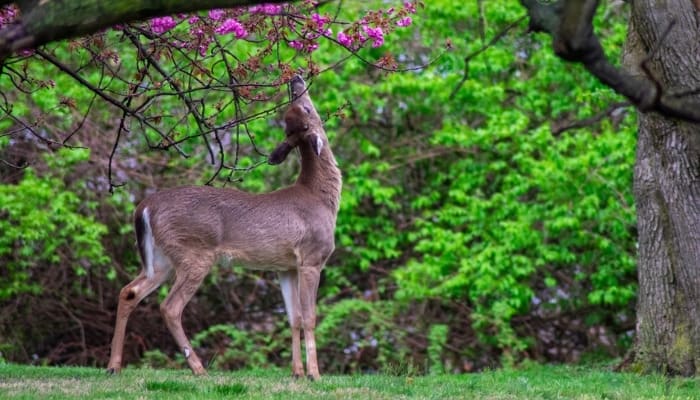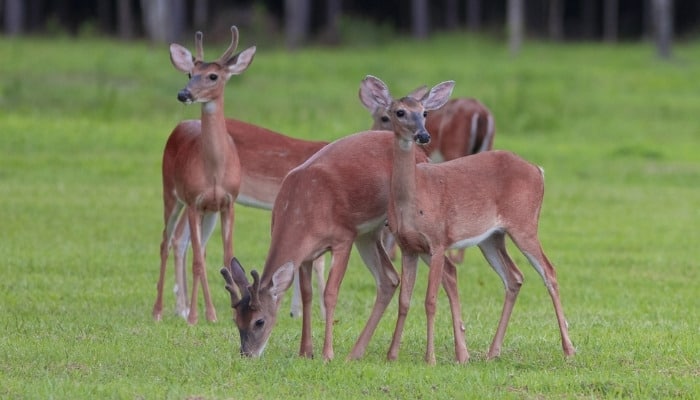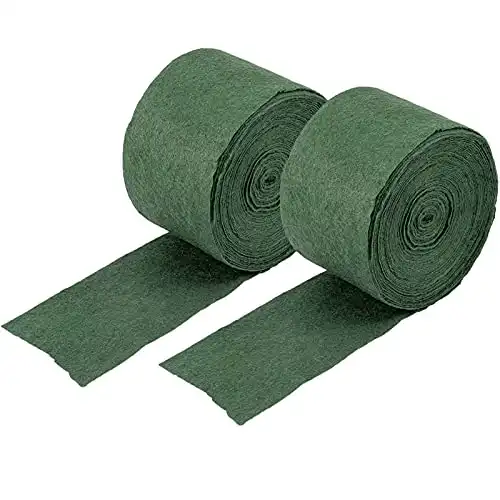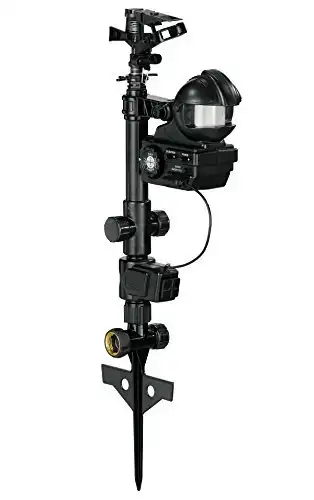Deer have various ways of causing harm to trees. Male deer often rub their antlers against tree trunks in order to remove the velvet and keep their antlers polished. Additionally, they may use trees to mark their territory through rubbing.
In winter, deer are likely to eat branches and bark when other food sources become scarce. It is important to find an effective solution to protect your trees from deer damage.
1. Mesh Tree Protectors
Mesh tree protectors are made from metal or plastic. They wrap around the trunk of the tree. Thanks to the mesh design, these protectors allow airflow and natural growth.
Male deer will still be able to rub their antlers on the tree, but they will not be able to damage the bark and the trunk.
Additionally, the mesh does not have openings large enough for deer to chew the bark. These protectors may need to be replaced or resized every couple of years as the trees grow.
2. Burlap
Burlap is an effective solution to many gardening issues. In addition to tree protection, burlap can be used to insulate plants in cold weather and control weeds in garden beds.
The burlap is wrapped around the tree trunk and secured. Just like the mesh tree protectors, deer will still be able to walk up to the tree, but they will not be able to eat the bark.
Since burlap is not rigid and can be ripped, antlers may be able to break through the burlap.
However, the feeling of rubbing on burlap is usually not as satisfying to the deer, and they may move on before any damage occurs.
3. Deer Fencing
Deer fencing is used to keep deer far away from the trees. It usually has an open mesh design and is made of plastic.
The fencing should be at least 6 or 8 feet tall to dissuade the deer from trying to jump over it. Angling the fencing up to 30° also helps prevent jumping.
This option is effective in preventing all kinds of deer-related damage to trees.
4. Wire Mesh Fencing
Wire mesh fencing, also known as hardware cloth, is similar to deer fencing. Since it is made of metal, wire mesh fencing is usually more expensive than plastic deer fencing.
However, it is sturdier and more likely to hold up against deer. You should install the fencing a couple of feet away from the tree to prevent deer from accessing the trunk.
5. Tree Wrap
Tree wrap is typically used to insulate tree trunks and shrubs in cold weather. It is also effective in preventing deer from chewing on bark or low branches.
For tree wraps to be most effective against deer, the wrap should be layered multiple times and secured tightly. Since this is a fabric product, aggressive antler rubbing could break through the material.
6. Motion-Activated Sprinklers
Using a motion-activated sprinkler is a humane way to actively deter deer from bothering your trees. The system is triggered by motion and sets off a water sprinkler.
Not only will the deer not want to be sprayed by the water, but the commotion of the sprinkler turning on is usually enough to spook any animal.
As a bonus, the motion-activated sprinkler can also be used as a regular sprinkler to water your trees.
7. All-Natural Deer Repellent Spray
There are several all-natural deer repellent sprays on the market, including this great option.
Deer repellent sprays work by combining natural ingredients that deer do not like the smell of or do not like the taste of.
Since these sprays use all-natural ingredients, they are safe for plants, pets, and children.
8. Coyote Urine Granules
To take advantage of a deer’s instinct to stay away from predators, use coyote urine granules. Deer will naturally avoid an area where they think a predator could be hanging out.
These granules can be spread throughout your garden and around trees as necessary. Other mammals may also be repelled by the smell.
9. Hang Soap in Trees
Surprisingly, deer seem to hate the smell of soap. The best way to take advantage of this is to hang bars of soap from the trees. Simply place the bars in mesh bags or pantyhose.
You’ll need to replace the bars around once a month, but timing will depend on how much rain your area receives.
10. Surround Trees With a Rock Garden
Deer have hooves that are strong, but they can have difficulty walking on uneven surfaces. Rocks are especially hard for deer hooves because the rocks can move and have rounded surfaces.
Adding a rock garden around your trees will make it near impossible for deer to access the trunks.
It is best to use medium-sized river rocks, but you can include pebbles and larger boulders as well.
11. Plant Deer-Resistant Trees

There are some kinds of trees that deer will avoid due to the smell and/or taste. Be aware that even the least appealing trees can be deer food during hard times.
The fewer food sources deer have, the more likely they are to eat food they don’t enjoy the flavor of.
Some of the most deer-resistant trees include pawpaw, Japanese plum yew, black tupelo, bald cypress, and fringe tree.
12. Homemade Repellent Spray
There are quite a few recipes for homemade deer repellent spray. Depending on the mixture, these sprays may be effective for a few hours to a few days.
Either way, you need to plan on reapplying. The key is to use ingredients that taste or smell off-putting to deer.
Popular recipes include egg and water or diluted hot sauce. These repellent sprays may prevent chewing, but they won’t always prevent males from rubbing their antlers.
13. Remove Plants That Attract Deer
It is a shame to remove plants from your garden, but it may be a necessary step if your deer problem has gotten out of control.
Deer enjoy plants like red clover, chicory, and orchard grass. Depending on the available food sources in your area, you may find deer chowing down on almost any of your garden plants.
Vegetable crops are also a favorite food for deer. Removing these food sources can make your garden less inviting for deer.
14. Take Down Bird Feeders at Night
Birdseed is an easy food source for hungry deer. It may not be their favorite food, but it is hard for them to pass up a meal served to them.
Many bird feeders are at the perfect height to be easily accessible by deer.
Since deer do most of their eating around dusk and throughout the night, taking down bird feeders before dark removes a food source.
Conclusion
Many gardeners love to invite wildlife into their yard, but sometimes those animals can end up being a nuisance.
These 14 methods for protecting your trees from deer will help you continue enjoying nature without suffering damage to your plants.









